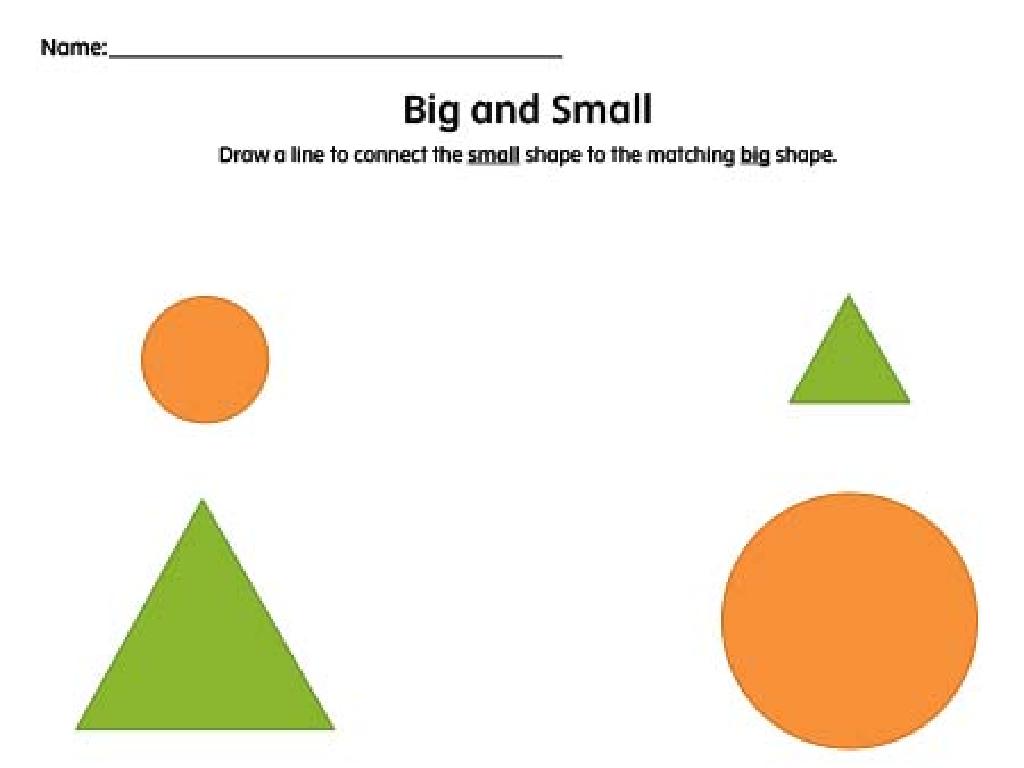Graph A Line Using Slope
Subject: Math
Grade: Eighth grade
Topic: Slope
Please LOG IN to download the presentation. Access is available to registered users only.
View More Content
Introduction to Slope
– Understanding slope in real life
– Slope measures steepness, like in roads or ramps
– Defining slope mathematically
– Slope is rise over run between two points
– Slope’s role in graphing lines
– It determines the direction and steepness of a line
– Why slope matters in math
– Slope is key in construction, art, and navigation
|
This slide introduces the concept of slope, which is a fundamental element in algebra and geometry. Start by discussing how slope is observed in everyday life, such as the incline of a hill or the pitch of a roof. Then, define slope from a mathematical perspective as the ratio of the vertical change (rise) to the horizontal change (run) between two points on a line. Emphasize the importance of slope in graphing lines, as it dictates the angle and direction of the line on a graph. Conclude by discussing the practical applications of understanding slope in various fields such as engineering, design, and navigation. Encourage students to think of other areas where slope is relevant. Provide examples and possibly a demonstration on how to calculate the slope from a graph or two given points.
Understanding Slope in Graphs
– Slope: ‘Rise over Run’
– Slope measures steepness of a line: vertical change (rise) over horizontal change (run).
– Calculate slope from points
– Use formula (y2 – y1) / (x2 – x1) between two points (x1, y1) and (x2, y2).
– Positive vs Negative Slope
– Positive slope: line rises as it moves right. Negative slope: line falls as it moves right.
– Graphing lines with slope
– Use slope and a point to plot and draw the line on a graph.
|
The concept of slope is fundamental in understanding linear relationships in algebra. Slope is defined as the ratio of the vertical change (rise) to the horizontal change (run) between two points on a line. When teaching this concept, emphasize the ‘rise over run’ mnemonic to help students remember the formula. Show how to calculate the slope using coordinates from two points on a line. Discuss the differences between positive and negative slopes, and how they represent the direction of a line on a graph. Provide examples of both positive and negative slopes, and demonstrate how to graph a line using the slope and a point. Encourage students to practice by calculating slopes from points and graphing lines on their own.
Graphing a Line Using Slope
– Identify slope and y-intercept
– Slope (m) is rise over run, y-intercept (b) is where line crosses y-axis
– Plot the y-intercept on the graph
– Start at the origin, move to the point where line intersects y-axis
– Use slope to find other points
– From y-intercept, use slope to locate another point on the line
– Draw the line through the points
– Connect y-intercept and other points with a straight edge for the line
|
Begin by explaining the concept of slope as the measure of steepness of a line, often expressed as ‘rise over run.’ Clarify that the y-intercept is the point where the line crosses the y-axis. Demonstrate plotting the y-intercept on a graph, then show how to use the slope to find another point on the line by moving up or down (rise) and left or right (run). Once two points are established, guide students to draw a straight line through these points, extending it across the graph. Provide examples and encourage students to practice with different slopes and y-intercepts to solidify their understanding.
Graphing Lines Using Slope
– Graphing a positive slope
– A positive slope rises from left to right
– Graphing a negative slope
– A negative slope falls from left to right
– Slope influences line direction
– Slope determines the steepness and direction of a line on the graph
– Practice with different slopes
|
This slide introduces students to the concept of slope and its visual representation on a graph. Start by explaining that slope is a measure of how steep a line is. Show how a positive slope results in a line that rises as it moves from left to right, which can be graphed using two points where the vertical change divided by the horizontal change is positive. Conversely, a negative slope results in a line that falls from left to right, with a negative ratio of vertical to horizontal change. Emphasize that the slope is a crucial factor in determining the direction and steepness of a line. Provide students with practice problems where they graph lines with different slopes to solidify their understanding.
Let’s Practice Graphing Lines!
– Graph line with slope 2/3 through (0, 2)
– Start at (0, 2), rise 2, run 3, plot points
– Graph line with slope -1/4 through (2, -1)
– Start at (2, -1), fall 1, run 4, plot points
|
This slide is designed for a class activity where students will practice graphing lines using given slopes and points. For the first problem, students should plot the y-intercept at (0, 2) and then use the slope to find another point by rising 2 units and running 3 units to the right. For the second problem, they should plot the point (2, -1) and then use the slope to find the next point by going down 1 unit and running 4 units to the right. Encourage students to draw a straight line through the points they’ve plotted. Provide graph paper and ensure they understand how to use the rise over run method to graph lines. Offer additional problems with different slopes and points for extra practice.
Class Activity: Create Your Own Slope Art!
– Understand slope through art
– Draw lines with different slopes
– Use a ruler to draw straight lines
– Label each line’s slope
– Calculate slope as rise over run
– Combine creativity with math
|
This activity is designed to help students apply their knowledge of slope in a creative context. Provide students with graph paper and ask them to draw various lines with different slopes, ensuring they label each line with the correct slope calculation. Encourage creativity; they can create a picture or an abstract design. This will reinforce the concept of slope as they see how changing the rise and run affects the steepness of the line. Possible variations for the activity: 1) Create a landscape with different slopes, 2) Design a city skyline using different line slopes, 3) Make a geometric pattern with lines of varying slopes, 4) Illustrate a scene from a story using lines with labeled slopes, 5) Have students exchange their artwork and calculate the slopes of each other’s lines.
Conclusion & Homework: Slope Practice
– Recap graphing lines with slope
– Emphasize importance of practice
– Homework: Real-life slope examples
– Find slopes around you, like roads or ramps
– Graph your findings
– Use the slope formula and graph paper
|
As we conclude today’s lesson on graphing lines using slope, it’s crucial to remind students that mastering this skill requires practice. Encourage them to review their notes and try additional problems at home. For homework, students should find real-life examples of slopes, such as wheelchair ramps, hills, or even stairs, and graph them using the slope-intercept form. This will help them understand the practical application of slopes in everyday life. Provide a brief demonstration of how to calculate slope from two points on a real-life object to ensure they are prepared for the homework. Remind them to bring their graphs to the next class for discussion.






